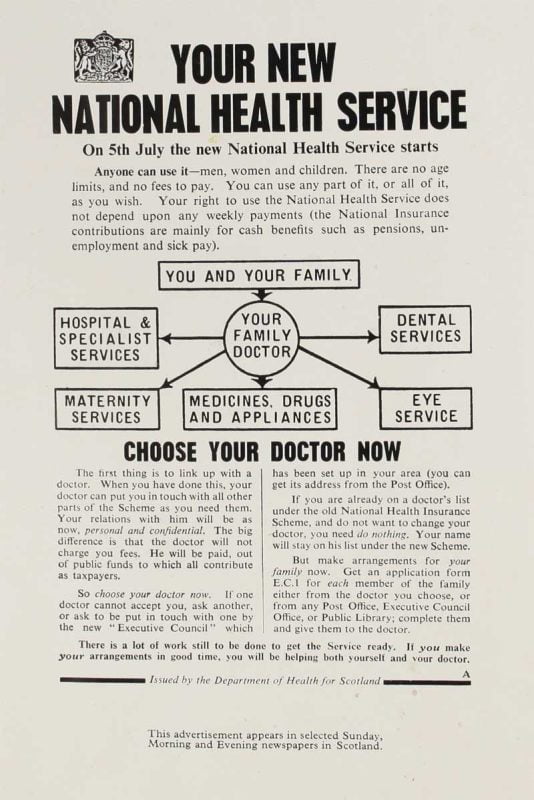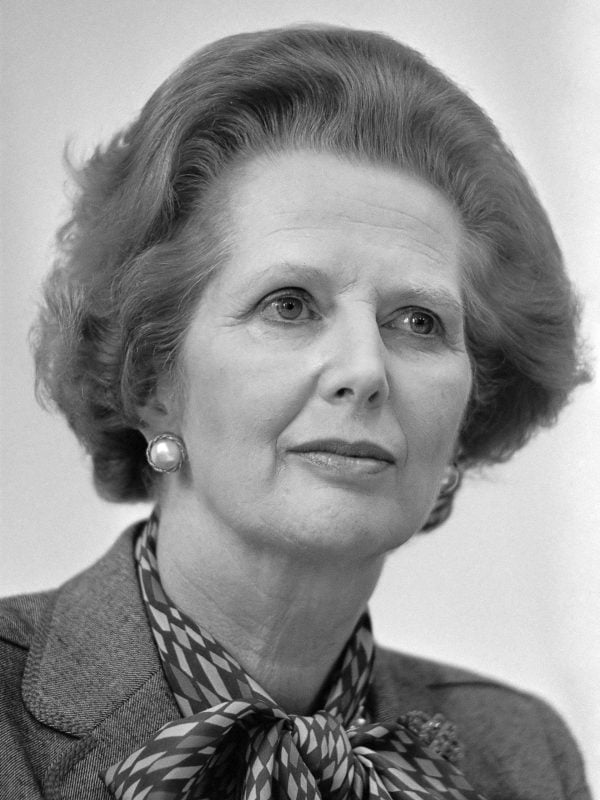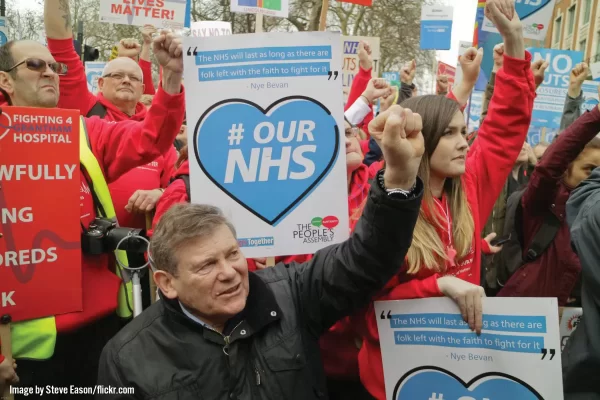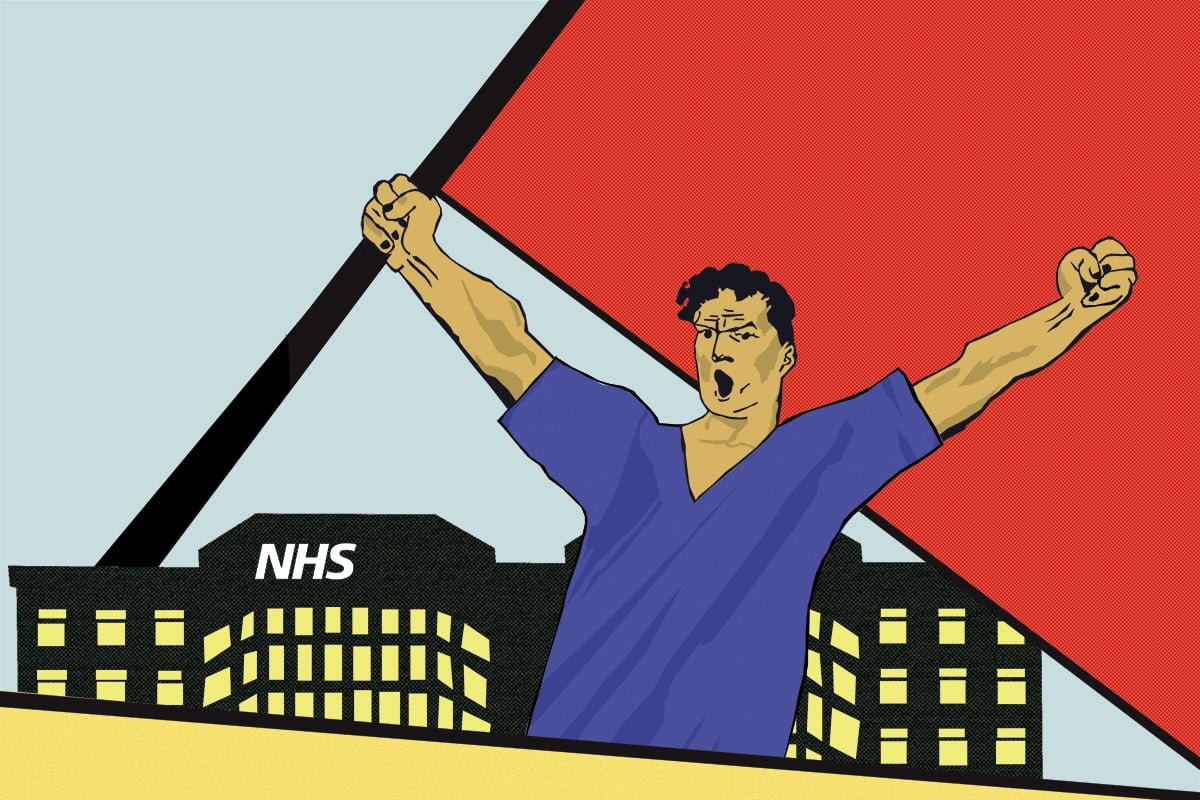75 years ago, the National Health Service (NHS) was founded, offering free state-funded healthcare for all. This was one of the greatest achievements of the working class in Britain to date.
Healthcare was revolutionised, radically improving living standards for ordinary people.
The NHS remains a pillar of British society. 55% of people say that it is what makes them most proud to be British – more than the Royal Family and the armed forces combined.
Decades of underfunding, understaffing, and mismanagement, however, have pushed it to the brink of collapse. Services have been cut to the bone. And staff are leaving in droves.
The crisis of capitalism is pushing millions into poverty – those who most need the NHS, but are found wanting.
Capitalism is in terminal decline, and can no longer offer meaningful reforms. All the hard-won gains of the working class are being stripped away.
To save the NHS, we must understand how it came to be – and why it will perish unless the working class fights to abolish capitalism.
Healthcare before the NHS
Prior to the NHS, healthcare services were abysmal. Those who could afford it could pay for private beds in voluntary hospitals, funded through philanthropy and run by volunteers.
These were often run by just one doctor, operating far beyond their competency. And visiting specialists would hand-select their patients based on intellectual interest.

For the working class, access to healthcare was non-existent. Up until 1929, those in workhouses were eligible for onsite care – free, but of very poor quality. Conditions in these ‘prisons for the poor’ were grim, and were ripe for the spread of infectious diseases.
Those not in workhouses would have to find a bed at a voluntary hospital. But these often only catered for specific clientele. Florence Nightingale, for example, worked in a voluntary hospital, providing care for “educated women of moderate means”.
The National Insurance Act brought in by the Lloyd George and the Liberal government in 1911 provided industrial workers with subsided health insurance. However, this didn’t extend to the workman’s family, and did not include hospital care.
After the abolition of the Poor Laws in 1929, many workhouses were converted into state infirmaries, providing free healthcare. But these institutions were so bad that many avoided them altogether. Many mothers even removed the hospital name from their children’s birth certificates.
Birth of the NHS
The Second World War exposed the inadequacies of the healthcare system. Only 40% of people had access to GPs. And in the 1930s, a national diphtheria vaccine was not rolled out, despite the disease killing 3000+ children per year.
In 1942, Liberal MP William Beveridge published the ‘Beveridge Report’, proposing a healthcare system funded through general taxation.
In normal times, such a report would have been filed away in a dusty drawer. But these were not normal times.
Following the destruction of the war and the Great Depression, nobody was prepared to return to conditions of unemployment, poverty, and misery. There was a deep yearning for change.
The overwhelming victory of Clement Attlee’s Labour government in the 1945 general election was met with jubilation in the streets. Working people expected radical reforms.
Attlee co-opted prominent lefts into key cabinet positions. This included self-proclaimed ‘Marxist’ Aneurin ‘Nye’ Bevan as health secretary, who presented the National Health Service Act in 1946.
It became the duty of the Minister of Health to “provide a comprehensive health service to improve mental and physical health of the people…and for services to be provided free of charge”.
This plan became widely popular. The Labour government couldn’t back down.
Despite the Tories today espousing their pride for the NHS, they were the fiercest opponents of its creation at the time.
At every turn, the Tories viciously fought the bill, voting against the creation of the NHS 22 times. One Tory MP, for example, claimed that the bill would “destroy so much in this country we value” – i.e. the capitalists’ profits.
In spite of opposition from the bosses and Tories, the bill passed. And so the NHS was born, on 5 July 1948.
A ‘piece’ of socialism
Attlee’s government only introduced the NHS due to pressure from the working class, who looked towards Labour to carry out a socialist programme.
Nye Bevan called the NHS “a piece of real socialism…[stood] opposed to the hedonism of capitalist society”. The key word here, however, is “piece”.

Labour had not broken with capitalism. Losses were nationalised, whilst profits remained privatised. Around 80% of the economy remained in private hands, with state intervention used to help the private sector.
Nationalised industries and services were not run democratically by the working class, but by unelected managers and bureaucrats. Consequently, from its birth, the NHS was run in a top-down, command-like fashion.
Furthermore, Labour watered down their programme under pressure from the bosses. Consequently, they lost power at the 1951 snap election.
Future Tory governments, however, could not remove the NHS, given its widespread support amongst the working class.
Crisis, cuts, and competition
The post-war economic upswing led to a boom in the building of hospitals. Although the NHS was far from perfect, it was a big jump compared to what had come before, so it was easy to look past any faults.
The world economic crisis in the 1970s, however, revealed the shortcomings of Britain’s public healthcare system.
There was no workers’ control, or any check on inefficiency and waste. Instead, a thick layer of bureaucratic management had developed.
A report published by the DFID Health Systems Resource Centre said: “For the nurse practising at ward level, there could be as many as four layers of management before reaching even the local sector…To many people working within it, the service felt top-heavy with managers.”
The 1974 Harold Wilson Labour government was one of crisis. Unwilling to break with capitalism, Labour was forced to carry out attacks on the working class.
Subsequently, Margaret Thatcher’s Tories came to power at the next election in 1979, waging an open class war to crush the labour movement and carry out sweeping privatisations.

Health staff were forced to report to hated managers. A cutthroat, business-like approach was expected. Yet by 2005, after 16 years of Tory rule, the cost of maintaining the bureaucracy had increased by 10%.
The NHS was opened up to private investors, competing for lucrative contracts. In 1983, competitive tendering was introduced for the outsourcing of ancillary services.
John Major’s Tory government expanded this with the 1990 NHS and Community Care act, introducing a purchaser/provider split, and splintering the NHS into an array of semi-autonomous trusts. Healthcare providers competed with one another over budget allocation. This was then used to purchase services from the private sector.
As a result, the newly-established trusts began cutting corners and focussing on hitting targets, rather than providing for need.
New Labour
By 1997, the Tories were a spent force. Tony Blair’s ‘New Labour’ swept into power. But instead of offering genuine reforms, they did the capitalist’s dirty work.
Blair abandoned Labour’s previous commitment to nationalised healthcare, and instead tightened the grip of the private sector.
Elective surgery, diagnostics, and procedures were all outsourced to private companies – at higher costs than providing these services in-house. Payment by results was introduced, allowing private companies to cherry-pick the most profitable parts of the NHS.
Labour revived the Tory ‘Private Finance Initiative’ (PFI) scheme – or as British Medical Journal editor Richard Smith coined it: ‘Perfidious Financial Idiocy’.

The state borrowed £12bn from private investors to build 100 new hospitals. The repayments for these loans reached a whopping £80bn, however, making up around one-sixth of hospital budgets today.
Gordon Brown’s government later facilitated the selling off of publicly-owned NHS land to pay for PFI repayments – a colossal waste that exposes the short-sighted and parasitic nature of the British capitalist class.
Austerity and pandemic
In response to the 2008 crash, the Tory-Lib-Dem coalition carried out brutal austerity and privatisation, making £20bn of cuts to the NHS.
The 2012 Health and Social Care Act no longer made it the responsibility of the health secretary to provide free healthcare, and contracts over £615,000 were available to tender for the private sector.
By the end of the decade, government spending on the NHS had flatlined, despite greater pressures. Budgets rose by just 1.4% per year, compared to earlier annual increases of 3.7%. Staff pay stagnated. And the number of people waiting for specialist care nearly doubled.
Despite having one of the world’s most advanced healthcare systems, the UK was one of the worst hit by the pandemic, with around 139,000 excess deaths.

Over-reliance on the private sector meant that colossal amounts of money were wasted when it came to procuring equipment and services. Thousands died, while private profiteers – quite literally – made a killing.
£37bn was spent on outsourcing the ‘NHS’ test-and-trace system to Deloitte and Serco. Contracts for the production of personal protective equipment (PPE) were handed out to private companies with no experience – including to a firm owned by the pub landlord of the then-health secretary Matt Hancock.
Approximately 1-in-5 items of PPE purchased by the government were not fit for purpose, leading to a waste of £15bn. And an estimated 1,500 healthcare workers died from COVID-19 due to a lack of adequate PPE.
The pandemic didn’t cause the crisis in the NHS. But it certainly revealed and widened the cracks.
Aftermath
The Tories’ 2022 Health and Care Act removed contract tendering, meaning that anybody can get an NHS contract (including pub landlords).
New planning bodies called ‘Integrated Care Systems’ were introduced. In the future, these could have private companies sitting on their boards, influencing budgets and imposing terms, conditions, and pay on health workers.
A record seven million patients are now awaiting a hospital appointment. An estimated 500 people are dying every week due to delays in obtaining treatment. And 1-in-5 people say that they no longer bother contacting their GP, due to the impossibility of reaching them.
Yet the Tories have said that they must make further ‘eye-watering’ cuts.
Save our NHS!
The NHS is not safe under capitalism. In the eyes of the ruling class, the NHS is an enormous drain. Public sector health workers do not produce profit directly for the capitalists. They are therefore considered unproductive.
This is why the NHS has been cut and privatised. The capitalists must constantly find ways to maximise profits. And in the NHS, they see a suckling pig with a juicy red apple in its mouth.

Under pressure from the working class, the post-war Labour government carried out major reforms. But today, the world economy teeters on the brink. And British capitalism faces its own special crisis.
The cupboard is bare. Instead of reforms, counter-reforms are on the order of the day.
Any government unwilling to break with capitalism will be forced by the ruling class to balance the books. This means savage cuts and attacks.
To save the NHS, the working class must do away with capitalism all together.
By expropriating the bankers and bosses, and putting the economy under a democratic plan, society’s plentiful resources could be used to properly invest in staff and services, and offer free, quality healthcare for all.
This is the socialist future that we must fight for.





